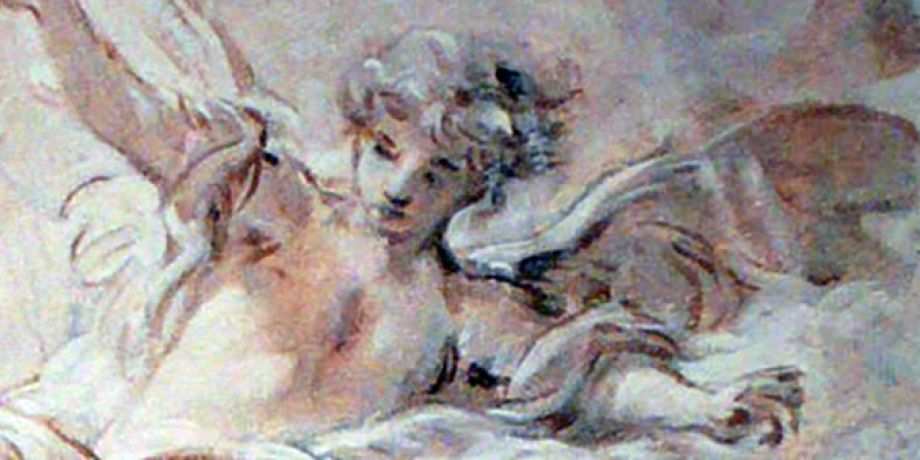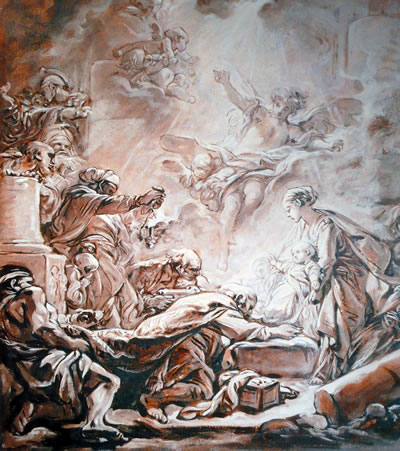
Our Sacred Journey
The Christmas/Epiphany cycle offers us generous glimpses into the mystery of the birth and manifestation of Jesus. The story of the Magi comes at the end of these glimpses and rich reflections of the Christmas season. This story has caught the imagination of the Christian tradition for centuries. Wise men or “astrologers” led by their own search of heavenly mysteries, begin their long journey “from the East” to Jerusalem in search of the prophesized newborn king of the Jews. Redirected to Bethlehem by Herod, they find, not the great king expected by the Israelites but a newborn infant, the Christ child.
 A second century fresco in the Priscilla Catacomb in Rome claims the first extant depiction of the Adoration of the Magi. In the 8th century, popular tradition gave them names, Balthasar, Melchior and Gaspar, and they were represented as the kings of Arabia, Persia and India, respectively. Marco Polo, on his travels through Iran, was said to have found the tombs of the three Magi, their bodies uncorrupted, their hair and beards intact. He inquired about their story and was told that one young astrologer, one middle-aged and one old, had set off from Saveh in modern Iran to find and worship a newborn prophet. In Chartres Cathedral in Paris, a carved panel shows the three kings warmly tucked up in bed, with crowns on their heads, while one of them is warned by an angel to avoid Herod on their return journey.
A second century fresco in the Priscilla Catacomb in Rome claims the first extant depiction of the Adoration of the Magi. In the 8th century, popular tradition gave them names, Balthasar, Melchior and Gaspar, and they were represented as the kings of Arabia, Persia and India, respectively. Marco Polo, on his travels through Iran, was said to have found the tombs of the three Magi, their bodies uncorrupted, their hair and beards intact. He inquired about their story and was told that one young astrologer, one middle-aged and one old, had set off from Saveh in modern Iran to find and worship a newborn prophet. In Chartres Cathedral in Paris, a carved panel shows the three kings warmly tucked up in bed, with crowns on their heads, while one of them is warned by an angel to avoid Herod on their return journey.
Returning to Matthew’s infancy narrative, we join the Magi, who were neither kings nor three, but gradually became depicted as young, middleaged and old. They are on a journey to Jerusalem to announce the birth of the savior. The experience of going on a sacred journey has accompanied the formation and renewal of people throughout history. Journeying is not merely a geographical adventure; it is a pilgrimage experience, a search for a deeper place. We long to touch holy ground. Often the pilgrim cannot express the depth of his or her search in words, but the outward adventure is a symbol of an inward search. For the Magi, the pilgrimage to Bethlehem was a privileged time and space for discovery, discernment and illumination. The luminous insight of Elizabeth Jennings in The Flowering of the Rod invites us to ponder the Magi’s extraordinary visit to the Child and his mother:
But she spoke so he looked at her, she was shy and simple and young;
she said, Sir, it is a most beautiful fragrance
as of all flowering things together; but Kaspar knew the seal of the jar was unbroken,
he did not know whether she knew
the fragrance came from the bundle of myrrh
she held in her arms.
A religious experience of having “observed his star at its rising” (Mt. 2:9) inspired them to come, and they found God in the humility of a fragile baby. “They knelt down and paid him homage.” (Mt. 2:11) The East in the persons of the Magi discovered the Christ child. New parents know the joy and the longing and the surrender and determined waiting until they bring their new baby home. To enter the manger and contemplatively ponder the newborn infant, or any newborn infant, is to step outside oneself, and, if only imperfectly, see the world afresh. It is as if God’s presence suddenly surprises us with the brilliant flash of a radiant star so that in the words of the poet, Patricia Rourke, “we are stunned by its arrival” when we discover God falling “softly ever so gently, into the night of our lives.” The Gospel tells us the visitors to the stable “were overwhelmed with joy” (v 10) when the star stopped over the place where the child was, and they instinctively knelt down and worshiped him. Like Luke’s shepherds, they saw, they were amazed and they pondered. (Lk. 2:17-19)
Matthew reminds us at the end of this story that they “left for their own country by another road.” (Mt. 2:12) It was a journey of transformation for the three star gazers. Having drawn near to the sacred, they were awakened to the mystery of their lives. They are now transformed by the experience of the Christ child in the manger, and ready to live in a completely new and reflective way. Just as the Easter liturgy invites us to ask Mary Magdalene: “Tell us Mary, what have you seen along the way?” The Christmas and Epiphany liturgies invite us to grasp the significance of the transcendental experience of our travelers from the East. Like Mary they could each reply: “I have seen the Lord!” Having been awakened to the mystery of their lives and touched and nourished by the energy of the divine, the Magi now return home ready to face the routine of life with new hope and purpose. They can now see the extraordinary in the ordinary and take notice of life in wonder. Their inward search has led them to a life of paying homage, a life of praise and gratitude.
Like the Magi, we too are led to Jesus. We are invited to come close to the borders of mystery, to search for God in the stable of our hearts and to contemplatively concentrate on the mystical dimensions of life so that we come completely into rhythm with our life in God. In Karl Rahner’s words, we are encompassed absolutely by God at the moment of our search as we journey through life by the light of the star. Insights from occasional moments of deep prayer, from reading the scriptures, our sensitivity to listening to the pain of a friend, or the problems of the poor, may be for us the star or the brilliant flash of light that leads us to the Child and His mother. We discover that the real journey is not to Bethlehem or to the stable but into our own hearts - our inner center which is largely shaped by our own experiences and the major options we make in life. Prayer and meditation enable us to integrate all our experiences into our inner center, or to partially or completely revise them. And as Meister Eckhart so gently reminds us, we may on occasion experience the brightness of the star as much “by the fireside or in the stable” as we do by devotions, ecstasies and contemplation.
Matthew’s reflection on the visit of the Magi invites us to travel home “by another road.” It also invites us to support all those who are searching for God in the humility of a fragile baby and who wish to travel home, transformed.
This reflection takes us to a new place. Where that new place is and how God is leading us there can emerge in our prayer, in our commitment and in our sharing of insights to enrich the community. We need a star from the East to direct us to Bethlehem and that star that shines over our personal mangers prepares us to welcome the Light of the World and to deepen our commitment to mission and mystery. The mystical experience of finding Jesus and of being completely encompassed by God must flow into our personal prayer, liturgies, our ministry and our homes, so that the mystery of God will spill over into our lives, into our world and into history.
The star over our personal mangers may help to expose the violence lurking within our own prejudiced hearts and hopefully guide us and our world on a new journey of respectful tolerance and peace. Like the Magi, we too hope to return home, to live the New Year with renewed generosity and commitment to peace, treasuring the presence of the Savior, “the fragrance…she held in her arms,” our God in human flesh. That is our sacred journey home “by another road.”
Columban Sr. Kathleen Coyle provided this reflection.